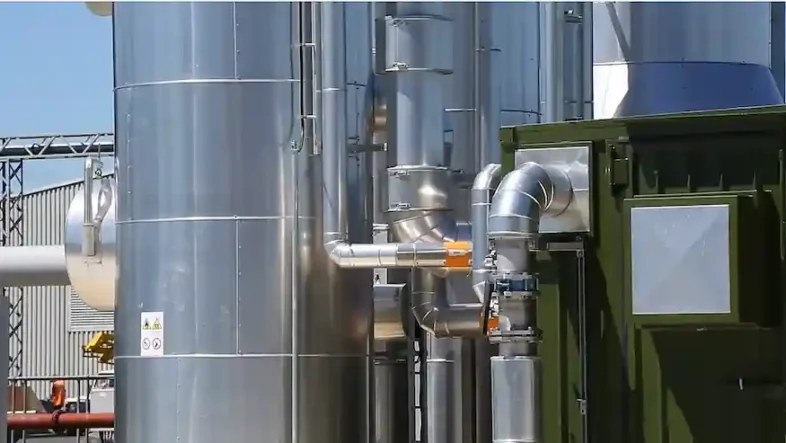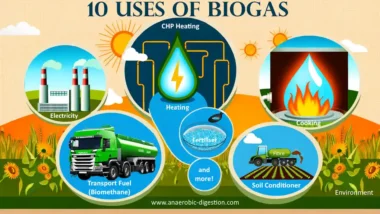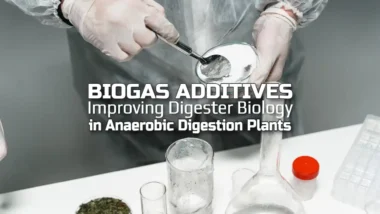Biomethane from sewage sludge is a success for STW: Discover how the Biogas Plant at Minworth STW (Sewage Treatment Works – or alternatively called a Wastewater Treatment Works is turning sewage sludge into renewable biomethane to heat 3,000 homes. Read on for a story of green energy innovation.
Are you concerned about how our everyday human waste contributes to climate change?
It's a worry that many of us share as we look for sustainable ways to tackle the global challenge of reducing the fossil fuel used to clean up (treat) the sewage we all help to make each time that we we flush the toilet.
One innovative solution is happening right here in the Midlands, where something as unpleasant as sewage sludge is being transformed into a valuable resource.
Severn Trent Water at Minworth Sewage Treatment Works has cracked the code by turning what we flush away into biomethane. This isn't just any gas—it's a renewable one capable of heating 3,000 homes in our community! Our blog post will delve into this remarkable process and show how your ‘waste' can warm up someone else’s home.
Ready for some good news about green energy? Keep reading to discover a story of transformation and hope.
Key Takeaways
- Severn Trent Water turns sewage sludge from the settlement of our foul waste into biomethane at Minworth Sewage Treatment Works, heating 3,000 UK homes since 2018.
- The process uses anaerobic digestion and a water scrubbing plant to clean up the raw biogas before purifying it still futher into high-quality biomethane for the National Grid.
- About 40GW hours of renewable gas is produced annually by the facility, marking significant steps towards sustainable energy production.
- Continuous monitoring ensures that only clean biomethane reaches the grid in line with the UK's stringent natural gas supply quality standards.
- Severn Trent Water aims for self-sufficiency in biomethane production and will raise its production of green gas to the National Grid and to power it's own sewage treatment energy requirements in line with its emissions reduction targets..
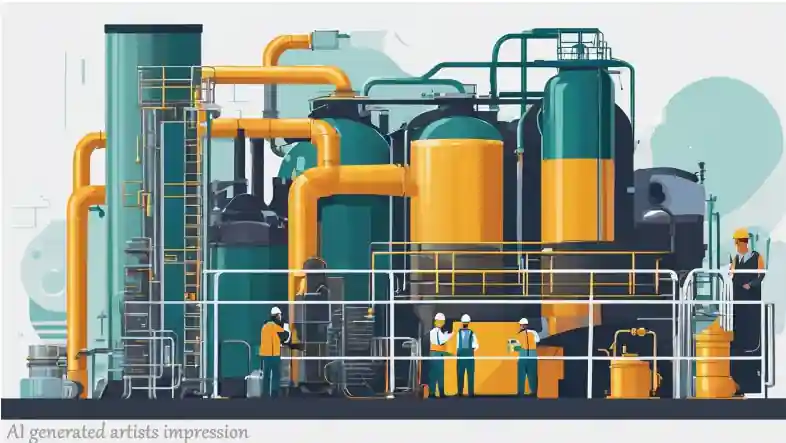
Background of Severn Trent Water biogas plants
Severn Trent Water operates multiple biogas plants across the UK, including the Minworth Sewage Treatment Works (STW). These plants are responsible for purifying biogas and reducing emissions in line with environmental targets.
Location and operations
Minworth Sewage Treatment Works is a key site for Severn Trent Water. Located in the Midlands, it stands out as their flagship facility for turning waste into energy. Here, they handle sewage sludge from homes and businesses.
The plant uses anaerobic digestion to break down this sludge. This process produces biogas.
The works operate around 35 similar sites across the region. Yet, Minworth STW is special because it's the first to upgrade its biogas with new technology. They face a big challenge due to varying quality of their raw material – the sewage sludge comes from many sources and each batch can be different.
Despite this, they manage to produce clean biomethane on a large scale.
Their operations at Minworth are significant in reaching emissions targets too. By purifying and using biogas, they cut down on greenhouse gases that would otherwise escape into our atmosphere if left untreated or used inefficiently.
The story of the STW biogas plant at Minworth is explained in detail in the video (recorded in 2016) below:

Biogas purification and emissions reduction targets
Severn Trent Water is turning waste into energy at Minworth STW. They use a process called anaerobic digestion to make biogas from sewage sludge. Then, they clean this biogas to create biomethane.
This pure gas goes into the National Grid to help heat homes across the UK.
Cleaning biogas cuts down on harmful emissions. Severn Trent aims high with their targets for reducing greenhouse gases. By purifying their biogas into biomethane, they support the UK's goals for cleaner air and lower carbon footprints.
Let's look closer at how Minworth STW produces biomethane from this process.
Biomethane Production at Minworth STW
Sewage sludge at Minworth STW is used to generate biomethane, which undergoes a purification process to upgrade its quality before being injected into the National Grid. This renewable gas can heat up to 3,000 UK homes, reducing reliance on non-renewable sources.
Similar progress is being made in France, as the video below describes:

Use of sewage sludge to generate biomethane
Minworth STW turns sewage sludge into a clean energy source through anaerobic digestion. This process breaks down the waste and produces biogas. Severn Trent Water then purifies this biogas to create biomethane, a renewable energy that can power homes.
They have been upgrading the quality of their biogas since 2011. The plant now successfully injects about 40GW hours of green gas into the national network. This is enough to warm up 3,000 homes in the UK using just what we flush away every day!
Upgrading biogas quality into biomethane
Severn Trent Water at Minworth STW takes biogas to the next level. They turn it into biomethane, a much cleaner fuel. This upgrading process transforms waste from sewage into valuable renewable energy.
It's a complex task because the feedstock they use is unpredictable.
Their method begins with a water scrubbing plant that purifies biogas efficiently. After treatment, the methane-rich gas needs to be just right before joining the National Grid. Workers check and adjust the quality round-the-clock to make sure everything meets strict standards.
The result? Pure biomethane ready for UK homes.
Injection into the National Grid
The journey of biomethane from sewage sludge to home heating starts at Minworth STW. Here, Severn Trent Water harnesses the power of anaerobic digestion. They turn waste into a renewable energy resource.
The upgraded biogas becomes high-quality biomethane. Then it’s ready for the next big step — entering the National Grid.
Purified biomethane gets compressed at an on-site plant before heading into the grid's distribution system. Workers keep a close watch, making sure only top-notch gas flows through to UK homes.
Their efforts pay off by sending about 40GW hours of this green gas yearly into the pipeline network, keeping thousands warm and cosy in their houses. This process marks a significant stride towards cleaner energy and sustainability across Britain.
Process of Biomethane Production
The treatment of biogas with a water scrubbing plant allows for the purification of gas, while compression plants push the purified gas into the National Grid Distribution System. Continuous monitoring ensures high-quality biomethane production.

Treatment of biogas with water scrubbing plant
Water scrubbing plants play a crucial role at Minworth Sewage Treatment Works. They clean the raw biogas by removing carbon dioxide and other impurities. This makes the gas pure enough to be called biomethane.
Clean biomethane can then go into our homes for heating and cooking.
Severn Trent Water has made this process really efficient. The water scrubbing technique ensures that almost all of the useful methane from sewage sludge does not go to waste.
It's a smart way to turn something dirty into clean energy for thousands of houses across the UK!
Compression plants for pushing purified gas into the National Grid Distribution System
Severn Trent Water's Minworth STW features advanced compression plants. These facilities take the cleaned biomethane and pump it into the UK's National Grid Distribution System. This action is crucial for moving renewable energy from sewage treatments to homes.
The compression plants work tirelessly to ensure a steady flow of gas. They push out approximately 40GW hours of biomethane energy, heating thousands of local houses. Monitoring ensures that only high-quality, purified gas enters the grid, supporting national efforts to cut emissions and promote clean energy use.
Continuous monitoring of gas quality
Severn Trent Water has rigorously monitored the quality of gas during biogas purification, ensuring it meets all necessary standards before injection into the National Grid. The company's continuous monitoring process includes thorough checks at 35 sites across the Midlands, guaranteeing that only purified gas meeting required standards is distributed.
By continuously monitoring gas quality, Severn Trent Water ensures the consistent supply of renewable gas into the UK's National Grid Distribution System, supporting sustainable energy initiatives in the region.
This achievement marks a significant step towards sustainable energy production and demonstrates the potential for utilising waste resources to meet energy demands. With this injection into the grid, Severn Trent Water sets a commendable example in driving renewable energy innovation within the UK's utilities sector.
Enough to heat 3,000 UK homes
The success of this initiative set a precedent for further advancements in renewable energy and signifies the crucial role sewage sludge can play in generating clean fuel for heating purposes. Other STW treatment works also now providing heating in their locality, such as at the Colehill STW (see video below).
STW's Aim for self-sufficiency in biomethane production
Severn Trent Water is striving for complete self-sufficiency in biomethane production from sewage sludge, a significant step towards sustainable energy. Injecting approximately 40GW hours of renewable gas into the grid in 2018, they now inject from additional plants and the quantity will keep rising as new biogas plants are built and commissioned.
The company's relentless efforts are focused on maximising efficiency in upgrading biogas quality into biomethane, setting an example for green innovation and resourcefulness.
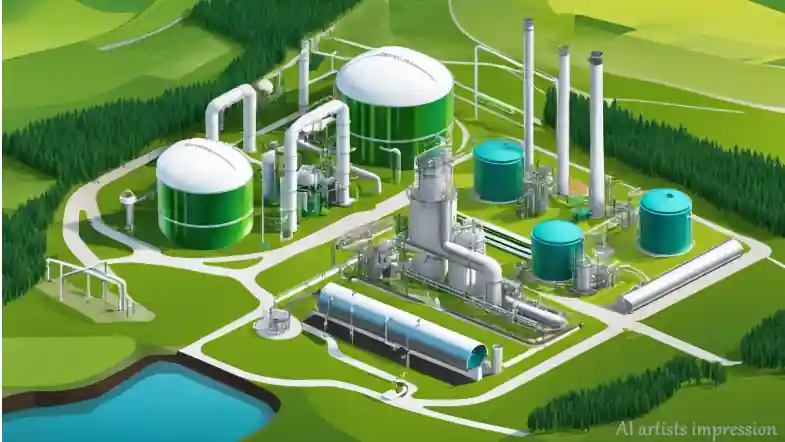
Conclusion
In conclusion, the process of generating biomethane from sewage sludge at Minworth STW is an innovative and sustainable approach to energy production. This practice not only contributes to meeting emissions reduction targets but also provides renewable gas to heat thousands of homes.
The practicality and efficiency of this method showcase its potential for widespread implementation in waste management facilities worldwide. Emphasising the importance of such initiatives can lead to significant improvements in environmental sustainability and resource utilisation.
For further insights into biomethane production or waste-to-energy solutions, exploring Severn Trent Water's future plans would provide valuable guidance for similar projects globally.
It's time we embrace such advancements for a greener and more sustainable future!
The video below is about the food waste digester at their STW wastewater Coleshill treatment plant near Birmingham:

FAQs
1. What is anaerobic digestion at Minworth STW?
Anaerobic digestion at Minworth Sewage Treatment Works (STW) is a process that breaks down sewage sludge to produce biogas.
2. Can the biogas from Severn Trent's process really heat homes?
Yes, the biomethane produced through Severn Trent's anaerobic digestion process can heat up to 3,000 homes.
3. Is the biomethane from Minworth STW clean energy?
The biomethane generated at Minworth STW through anaerobic digestion by Severn Trent is a renewable and clean energy source.
4. How does Severn Trent use anaerobic digestion to help the environment?
Severn Trent uses anaerobic digestion to turn waste into useful biogas, reducing waste and making sustainable energy for heating homes.
Biomethane from Sewage Sludge at Minworth STW Heats 3,000 UK Homes
Original Article archive, published 2 February 2018:
This is the story of how one UK water utility company is making biomethane from sewage sludge and helping the UK meet emissions reduction targets. They are purifying biogas into pure methane (biomethane) renewable energy, and reducing carbon dioxide emissions substantially. They are doing this by using their own sewage sludge waste product at Minworth Sewage Treatment Works, where in addition to making electricity, a CHP Unit also heats 3,000 local homes.
Severn Trent Water is a major water and waste utility located in the middle of the UK. They operate from the Midlands, around Birmingham, out into Wales and a major part of their business that is growing at the moment, is renewable energy production from the biomethane from sewage sludge.
They have a number of sites, around about 35, across the Midlands where they treat sewage sludge and use it to generate electricity through the use of Combined Heat and Power engines.
Biomethane from Sewage Sludge – the Latest in a Sequence of CO2 Emissions Reducing Improvements since 2011.
Their site in Minworth is particularly interesting, because they have been making biogas from sewage sludge there and generating electricity for about 50 years. They were previously doing this using the anaerobic digestion process, on-site to generate electricity from the raw biogas. For many years they have fed both electricity and heat as well, using CHP (Combined Heat and Power) engines that have allowed them to generate electricity, power and heat the site, and feed the local electricity grid.
Since 2011 they've developed an alternative to this by upgrading their biogas quality into biomethane (natural gas quality) and injecting it out into the National Grid in the form of methane gas.
The site here was the first to upgrade biogas from sewage treatment works where they don't have a great control over their feedstock, or what's coming into the site.
To overcome this they have a number of process steps in place, to treat the biogas and generate the maximum efficiency.
The first step, is that they look at removing a lot of the volatile organic compounds that are in the raw biogas that's coming off their sludge digestion plant.
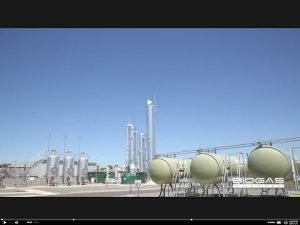 The digestion plant is quite old. It's a standard mesophilic digester, but it produces gas that can contain impurities of anything from siloxanes (which cause problems for combustion plants if they pass out into the network), or odorants that we might find in shampoos or shower gels. Odorants could cause an impact on the gas as it flows out through the system.
The digestion plant is quite old. It's a standard mesophilic digester, but it produces gas that can contain impurities of anything from siloxanes (which cause problems for combustion plants if they pass out into the network), or odorants that we might find in shampoos or shower gels. Odorants could cause an impact on the gas as it flows out through the system.
The need to remove remove these, and other unwanted constituents, with an activated carbon treatment system. This is at the front-end of the process, so that they can get on with the real business of upgrading the biogas, as you might well have read about on other sites around the UK.
At Minworth, STW decided to utilise a water scrubbing plant. They made this choice this because they had seen it operating at a number of places on the continent. The STW experts were able to visit sludge upgrading at some of those plants. They were able to see the sewage sludge, and see it being upgraded at the flows and the quantities that they desired.
In principle, there are a number of technologies that people can be used to achieve the transformation of sewage sludge to biomethane, but because of the variability of the feedstock and the variability of the gas that they had, the water scrubber was found to be the most resilient.
They were also the first site in the UK to inject natural gas quality biomethane into the local transmission system. That means the National Grid's slightly higher pressure system between 15 and 20 bar gauge pressure, and what that meant was they had to introduce new biomethane compression plants. These were built on the site, and new monitoring equipment at the end. So once they've purified that gas, and got it purified to around 97/98% methane, they compress it, before we pushing it out into the UK's National Grid Distribution System.
This gas (biomethane) is now 100% ready to go into the grid, and STW have a system where they run some checks, and monitor continuously. They constantly collect data on the quality of their output of biomethane gas and the performance of that gas. They do that before they pass it under the road into the local transmission system. National Grid take it away from the sewage works, for use in the domestic network. They benefit of this way of working is considerably higher efficiency energy distribution than they say that they been able to achieve before.
“The biomethane upgrading process has been an excellent addition to our energy portfolio and to date we've run it for nine months with minimal problems since commissioning and we've injected around about 40GW hours of renewable gas.”
We are informed that this gas is approximately enough to heat 3,000 UK homes, but what they use it for is mitigating their gas use as a company. They now intend to be completely self sufficient in the production of biomethane from sewage sludge that they use to operate their business, on a daily basis. As found on Youtube
More About Sewage Sludge – Click Here.
[First published 2 February 2018.]

